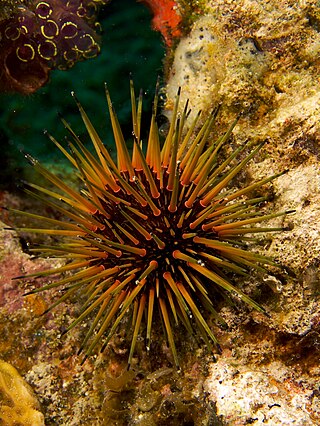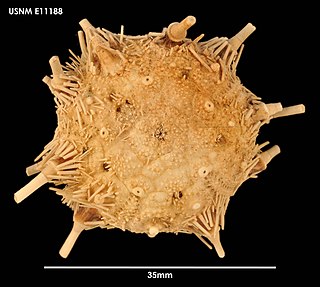
The Echinothurioida are an order of sea urchins in the class Echinoidea. Echinothurioids are distinguished from other sea urchins by the combination of a flexible test and hollow spines. The membrane around the mouth contains only simple plates, in contrast to the more complex mouth parts of their close relatives, the Diadematoida. They are nearly all deepsea dwellers.

Amphipneustes similis is a species of sea urchin of the family Temnopleuridae. Their armour is covered with spines. It is placed in the genus Amphipneustes and lives in the sea. Amphipneustes similis was first scientifically described in 1936 by Ole Mortensen, Danish zoologist.
Amphipneustes tumescens is a species of sea urchin of the family Temnopleuridae. Their armour is covered with spines. It is placed in the genus Amphipneustes and lives in the sea. Amphipneustes tumescens was first scientifically described in 1926 by Koehler.
Anabrissus damesi is a species of sea urchin of the family Brissidae. Their armour is covered with spines. It is placed in the genus Anabrissus and lives in the sea. Anabrissus damesi was first scientifically described in 1881 by Alexander Agassiz, American scientist and engineer.
Antrechinus drygalskii is a species of sea urchin of the family Urechinidae. Their armour is covered with spines. It is placed in the genus Antrechinus and lives in the sea. Antrechinus drygalskii was first scientifically described in 1905 by Ole Mortensen, Danish zoologist.
Aspidodiadema jacobyi is a small sea urchin in the family Aspidodiadematidae. It lives in tropical seas at great depths. Aspidodiadema jacobyi was first scientifically described in 1880 by Alexander Emanuel Agassiz, an American scientist.
Araeosoma alternatum is a species of sea urchin of the family Echinothuriidae. Its armour is covered with spines. It is placed in the genus Araeosoma and lives in the sea. A. alternatum was first scientifically described in 1934 by Ole Theodor Jensen Mortensen, a Danish zoologist.
Araeosoma belli is a species of sea urchin of the family Echinothuriidae. Its armour is covered with spines. It is placed in the genus Araeosoma and lives throughout the Caribbean Sea as well as areas around the Gulf of Mexico. A. belli was first scientifically described in 1903 by Ole Theodor Jensen Mortensen, a Danish zoologist.

Araeosoma coriaceum is a species of sea urchin of the family Echinothuriidae. Its armour is covered with spines. It is placed in the genus Araeosoma and lives in the sea. A. coriaceum was first scientifically described in 1879 by Alexander Emanuel Agassiz, an American scientist.

Echinometra viridis, the reef urchin, is a species of sea urchin in the family Echinometridae. It is found on reefs in very shallow parts of the western Atlantic Ocean and the Caribbean Sea.
Aspidodiadema tonsum is a species of sea urchin of the family Aspidodiadematidae. Their armour is covered with spines. It is placed in the genus Aspidodiadema and lives in the sea. Aspidodiadema tonsum was first scientifically described in 1879 by Alexander Emanuel Agassiz.
Ceratophysa rosea is a species of sea urchins of the Family Pourtalesiidae. Their armour is covered with spines. Ceratophysa rosea was first scientifically described in 1879 by Alexander Emanuel Agassiz.

Cidaris blakei is a species of sea urchins of the family Cidaridae. Its armour is covered with spines of three types, one unique type being extended and fan-like, making it easily recognized. Alexander Agassiz first described it scientifically in 1878. It is present on the seabed in deep waters in the Gulf of Mexico and the Bahamas.
Cionobrissus revinctus is a species of sea urchins of the Family Brissidae. Their armour is covered with spines. Cionobrissus revinctus was first scientifically described in 1879 by Alexander Emanuel Agassiz.

Chaetodiadema is a genus of sea urchins of the Family Diadematidae. Their armour is covered with spines.

Araeosoma is a genus of deep-sea sea urchins in the family Echinothuriidae.

Aporocidaris is a genus of sea urchins in the family Ctenocidaridae. Several species are found in deep water in circum-Antarctic locations.

Pseudocentrotus depressus, commonly known as the pink sea urchin, is a species of sea urchin, one of only two species in the genus Pseudocentrotus. It was first described in 1864 by the American marine zoologist Alexander Agassiz as Toxocidaris depressus, having been collected during the North Pacific Exploring and Surveying Expedition undertaken by Captain Cadwalader Ringgold and later Captain John Rodgers.

Tetrapygus is a genus of sea urchins in the family Arbaciidae. It is a monotypic genus and the only species is Tetrapygus niger which was first described by the Chilean naturalist Juan Ignacio Molina in 1782. It is found in the southeastern Pacific Ocean on the coasts of South America.

Parechinus angulosus, the Cape urchin, is a sea urchin in the family Parechinidae endemic to southern Africa. It is the only species in the genus Parechinus.











